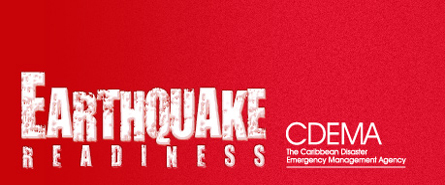|
An earthquake may not actually occur during the childhood of students. However, the earthquake safety lessons they learn will stay with them and be useful in adulthood, both for themselves and to pass on to their children.
Earthquakes are a particular concern for schools with their large concentrations of children in confined spaces, and a relatively low ratio of adults to children. Schools need to ensure buildings are more earthquake-proof, include earthquake preparedness in emergency plans, teach children and staff what to do if an earthquake happens, and keep emergency supplies on hand.
Evacuation:
Once the teacher/monitor has taken a decision to evacuate:
- Teachers should:
- INSTRUCT students to evacuate upon taking a decision that this is the most appropriate course of action.
- LEAD class to the designated assembly area.
- BE PREPARED to choose alternative escape route in case of fire or exit blockage.
- TAKE class list, I.D. tags, first aid kit.
- APPLY I.D. information to all primary and injured students.
- GIVE FIRST AID, if necessary.
- DO NOT RE-ENTER the building unless instructed by the emergency responders.
- Students should:
- EVACUATE the building in single file when instructed by the teacher or monitor.
- KEEP CALM.
- WEAR SHOES.
- DO NOT USE an elevator.
Teacher Checklists
- Before:
- Hold classroom discussion
- Practice drills
- Hold hazard hunts, correct hazards where possible
- Appoint two student monitors in case you are injured
- Prepare class lists and identification tags with name, address, phone number, age and medic alert information.
back to top
- During:
- Issue the "EARTHQUAKE" order at first sign of tremor
- Drop, Cover and Hold until the shaking stops
- Talk calmly to reassure students
- Assess the situation to determine whether or not to evacuate
- Respond as required
- Review evacuation procedures.
- To Evacuate:
- Instruct students to evacuate lead class to the designated assembly area
- Be prepared to choose alternative escape route in case of fire or exit blockage
- Take class list, I.D. tags, and first aid kit
- Administer first aid, if necessary
- Do not re-enter the building unless instructed by the principal
- Write I.D. information on foreheads of primary and injured children, if tags not available
- Reassure students
- Remind students that parents may be delayed in calling for them
- Encourage students to talk about their fears and anxieties.
School Safety Programme and Disaster Plan
An earthquake safety programme should be established and maintained in every school, either individually or by district. To organise this programme, the Ministry of Education in collaboration with the NDO should form Earthquake Safety Committees to cover appropriate geographic areas or districts. CLICK HERE FOR MORE INFORMATION FOR EDUCATION POLICY MAKERS.
The NDO is an excellent resource, and should be consulted for templates on creating disaster plans. Local school responsibilities can either be undertaken by the principal personally, or delegated to a school working group, comprising perhaps an administrator, a teacher, a parent, and a senior grade student in the case of a secondary or high school.
A disaster plan should provide short-term shelter (i.e., one to two hours) for the entire school population and make provisions for students whose parents have been unable to collect them. The long-term plan must take into account the fact that an earthquake can occur at any time during the day; that the building may be unsafe for re-entering; and that all services, including telephones, may be disrupted.
The following planning decisions should be made in preparation for the first two hours in the aftermath of an earthquake:
- Who will give instructions to evacuate the building?
- How will this be done if the P.A. system is damaged?
- What should be done if an aftershock occurs during evacuation?
- Have evacuation routes and assembly areas been established? Are they the same as fire escape routes and areas? If not, why not and could this cause confusion?
- Are there any potential hazards along the evacuation routes?
- What emergencies could occur and what should be done (e.g., power fails, exit door jams, debris blocks exit, fire breaks out, students are injured and should not be moved)?
- Under the worst weather conditions possible, where will the school population find short-term shelter?
- How will all persons be identified and kept track of?
- How will the arrival of parents and the handover of their children be processed?
- What steps can be taken to reduce anxiety and fear among students and adults?
- If it is necessary to evacuate the school grounds, how will this be accomplished and how will parents be informed of the new location?
back to top
In addition, the following information should be established:
- Chain of command for decisions after an earthquake.
- List of emergency response agencies (e.g., fire, police, gas utility, electricity utility).
- Procedures to provide for first aid, search and rescue, communication, building damage assessment and student security.
- Identification of trained persons within the school community or local area who are prepared and able to administer first aid immediately after the earthquake. These may include local business persons, neighbours, school counsellors, nurse and psychologist. Ensure that such persons are trained and known to all of the students and faculty.
- Location(s) of outdoor assembly areas, first aid stations, command and communication stations, and student release station.
- List of persons responsible for various actions and/or with required skills.
- Identification of two student monitors per class to be designated with the authority to give instructions in the even their teacher is injured. These should be trained in proper reaction and evacuation protocols.
- Inventory of supplies and a plan of the school.
Expert judgment may be needed to determine whether buildings are safe for re-entry. The emergency response plan should contain names of local engineers and other experts who can assess the following:
- Structural and non-structural damage
- Damage to utilities
- The likelihood of fire
- Hazardous material spills
Quick Points
- Return to routine as soon as possible.
- Express your own concerns openly and let students know that it is normal to be afraid.
- Encourage children to talk, draw and write about their fears, and help them sort real from unreal.
- Do not criticize apparently "babyish" behavior. Some regress, and begin to suck thumbs, wet beds, report mysterious pains, or have difficulty eating or sleeping.
- Help parents to understand their children's behavior, and be aware of parents' fears. Some may be afraid to leave their children. Others may be angry or upset because their children are afraid. Reassure them that with support, most children recover without lasting problems.
- If a child continues to be disturbed for more than a few weeks, the family may need professional counseling. Some children do experience long-term problems such as depression and post-traumatic stress disorder, and require treatment.
- You may also have emotional difficulties after a traumatic event, and need to take care of yourself.
back to top
|













